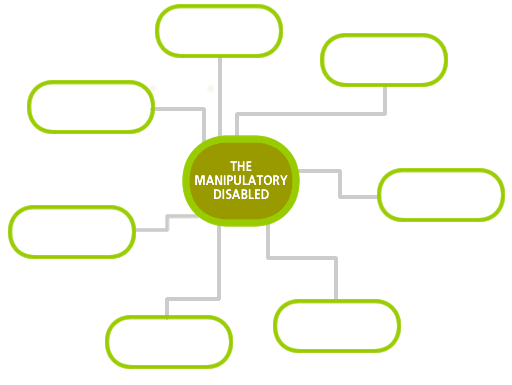

| STUDENT'S WORKSHEET |The Manipulatory Disabled | |||||||||||||||||||||||||||||||||||||||||||||||||||
| 3.2.1. The Manipulatory Disabled | |||||||||||||||||||||||||||||||||||||||||||||||||||
| Activity 1 | |||||||||||||||||||||||||||||||||||||||||||||||||||
|
:: Your teacher will give you a scarf that you will tie round your arm in a sling. Don't take it off.
|
|||||||||||||||||||||||||||||||||||||||||||||||||||
| Activity 2 | |||||||||||||||||||||||||||||||||||||||||||||||||||
|
:: Select six words from the Feelings Words List to describe your feelings while you could not move your hand and/or arm. Then make sentences and give a reason. Example: |
|||||||||||||||||||||||||||||||||||||||||||||||||||
|
|||||||||||||||||||||||||||||||||||||||||||||||||||
|
|||||||||||||||||||||||||||||||||||||||||||||||||||
| Activity 3 | |||||||||||||||||||||||||||||||||||||||||||||||||||
|
:: Read your sentences aloud and comment on your feelings with your classmates.
|
|||||||||||||||||||||||||||||||||||||||||||||||||||
| Activity 4 | |||||||||||||||||||||||||||||||||||||||||||||||||||
|
:: Read 3.1 The Manipulatory Disabled | A) Some Basic Characteristics and then complete the following cluster map with the basic characteristics of the manipulatory disabled. :: Of course, you may want to include others which are not in the text (you should write the linking words on the arrows). |
|||||||||||||||||||||||||||||||||||||||||||||||||||
|
|
|||||||||||||||||||||||||||||||||||||||||||||||||||
| Activity 5 | |||||||||||||||||||||||||||||||||||||||||||||||||||
|
:: Read 3.1 The Manipulatory Disabled | B) Accessible Environments and the Manipulatory Disabled. ::
Tick
( :: Write a cross (x) if the element is not at all suitable for the manipulatory disabled.
::
Tick
( |
|||||||||||||||||||||||||||||||||||||||||||||||||||
|
|||||||||||||||||||||||||||||||||||||||||||||||||||
| Activity 6 | |||||||||||||||||||||||||||||||||||||||||||||||||||
|
:: Read and comment on the above chart with your classmates.
|
|||||||||||||||||||||||||||||||||||||||||||||||||||
| Written Exercises | |||||||||||||||||||||||||||||||||||||||||||||||||||
|
|
|||||||||||||||||||||||||||||||||||||||||||||||||||
